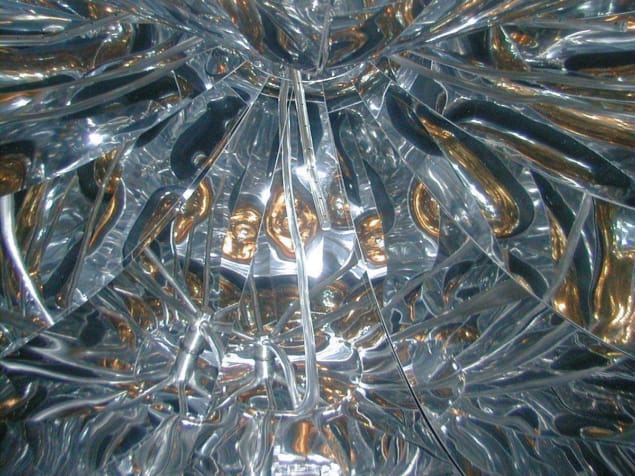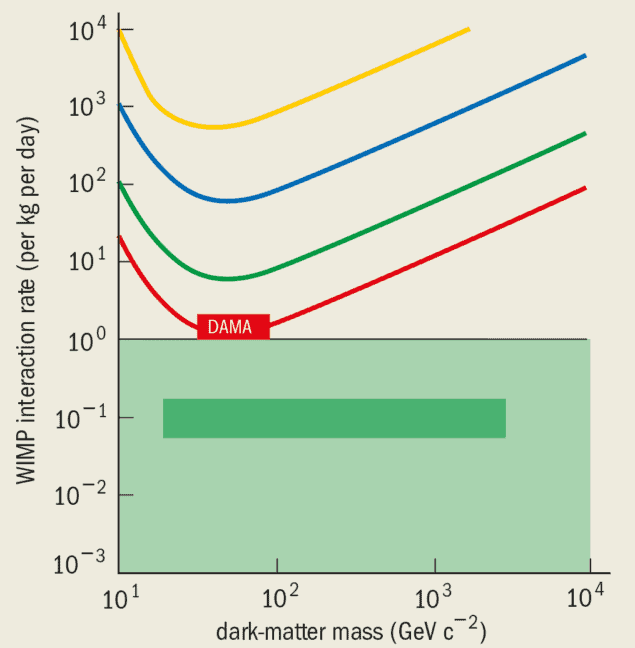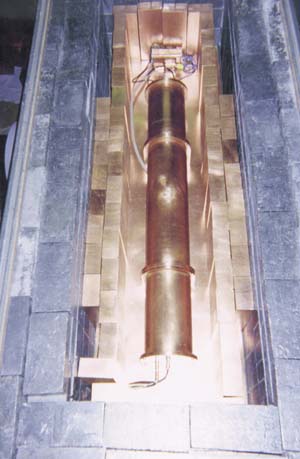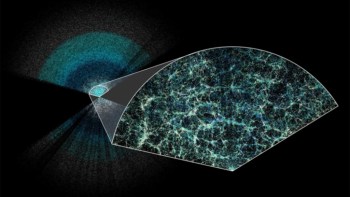Experiments housed deep underground are searching for new particles that could simultaneously solve one of the biggest mysteries in astrophysics and reveal what lies beyond the Standard Model of particle physics

Physicists are very particular about balancing budgets. Energy, charge and momentum all have to be conserved – and often money as well. Astronomers were therefore surprised and disturbed to learn in the 1930s that our own Milky Way galaxy behaved as if it contained more matter than could be seen with telescopes. This puzzling non-luminous matter became known as “dark matter” and we now know that over 90% of the matter in the entire universe is dark.
In later decades the search for this dark matter shifted from the heavens to the Earth. In fact, the search for dark matter went underground. Today there are experiments searching for dark matter hundreds and thousands of metres below ground in mines, road tunnels and other subterranean locations. These experiments are becoming more sensitive every year and are beginning to test various new models and theories in particle physics and cosmology.
Cosmological implications
On a galactic scale the most direct evidence for dark matter comes from observations of the rotation of spiral galaxies like the Milky Way. By measuring Doppler shifts it is possible to determine the rotation speeds of stars and gas at various distances from the centre of the galaxy. This in turn allows us to calculate the mass of the galaxy. However, this mass is about an order of magnitude larger than the mass of all the stars and gas that can be seen in the galaxy. It appears that at least 90% of the mass of any galaxy – and possibly as much as 99% of the mass of the universe – is in the form of matter that cannot be seen. What is this dark matter made of?
Astronomers have long been aware of many objects that do not emit electromagnetic radiation, and early candidates for the dark matter in galaxies included planets, dead or unborn stars, and black holes. These objects are collectively known as massive astrophysical compact halo objects or MACHOs, and they can be detected through a phenomenon known as gravitational lensing. When a massive object such as a MACHO passes between the Earth and a distant star, its gravitational field will cause the light from the star to bend, which leads to a characteristic change in the brightness of the star. But the chances of this happening are very small, so it is necessary to observe millions of stars to record just a few lensing events. Searches are underway by half a dozen groups worldwide, including the Australian/US MACHO collaboration and the French EROS team. Recent results from the EROS collaboration suggest that no more than about 20% of the dark matter in our galaxy is in the form of MACHOs.
The amount of dark matter in the universe as a whole has a bearing on its ultimate fate. As Edwin Hubble first deduced in the 1920s, the universe is expanding from a big bang some 10 to 15 billion years ago. If the overall density of the universe is below a “critical density”, then the gravitational attraction of its constituents will not be able to halt this expansion and the universe will expand forever. On the other hand, if the density is greater than the critical value, the expansion will be halted and then reversed, and the universe will ultimately experience a “big crunch”.
At the critical density, the universe asymptotically approaches some size. Large-scale observations of our universe seem to indicate that we live in this final scenario. This is also supported by the theory of inflation – in which the universe underwent an extremely short (about 10-32 seconds) period of rapid expansion just after the big bang – although as yet there is no experimental evidence for this.
Accounting for this critical density poses another budgetary problem. Prior to Hubble’s discovery that the universe was expanding, Einstein had modified his general theory of relativity by introducing a “cosmological constant” that acted against gravity to produce a static universe. After Hubble’s discovery Einstein called the cosmological constant his “greatest blunder”, but recent observations of distant supernovae suggest that this constant might actually account for 70% of the critical density. (The supernova observations suggest an “accelerating universe” in which the expansion is becoming faster rather than slower, although this is still under debate in the astrophysics community.)
The application of well established nuclear physics to the epoch of nuclear formation – between about 3 and 15 minutes after the big bang – allows the abundances of deuterium, helium, lithium and other light elements to be predicted. These values depend on the density of protons and neutrons, which are collectively called baryons. Observations of the current abundances of these elements imply that the density of baryons in the universe can be no more than about 5% of the critical density. Together with the results of the direct searches for MACHOs (which are also baryonic), the astronomical evidence indicates that the majority of the matter in the universe is both non-baryonic and dark.
Particle-physics implications
High-energy physicists have proposed various candidates for non-baryonic dark matter, all of which would indicate new physics beyond the well tested Standard Model of particle physics. In the Standard Model, matter is made from quarks and leptons (electrons, muons and tau particles), and there are four forces – gravity plus the strong, weak and electromagnetic forces – that can act between the matter particles. The forces are carried by particles such as the photon, which is responsible for electromagnetism, and the W and Z bosons, which carry the unified electroweak force. The Standard Model is completed by the three families or flavours of neutrinos corresponding to the three families of leptons.
Early in the search for dark matter it was realized that if the neutrino had a mass in the range 10-50 eV c-2 (the electron, in comparison, has a mass of 500 000 eV c-2), then the enormous number of neutrinos created during the big bang would be able to account for all the dark matter in the universe. Although the neutrino has zero mass in the Standard Model, various extensions of the model do allow it to have a mass. In recent years, observations of solar and atmospheric neutrinos have indicated that one flavour can change into another, which can only happen if the neutrino has mass.

The best evidence for neutrino mass comes from the SuperKamiokande experiment, which is situated 1000 metres below ground in a lead and zinc mine in Japan (see “Neutrino mass discovered” by Lincoln Wolfenstein Physics World July 1998 pp 17-18). SuperKamiokande detects muon neutrinos produced when cosmic rays collide with molecules in the atmosphere. Fewer neutrinos are detected from below than above, suggesting that the muon neutrinos have changed into tau neutrinos on their journey through the Earth. The results indicate a mass difference of ~0.05 eV c-2 between the muon neutrino and the tau neutrino.
If the masses of the neutrinos follow the same pattern as the masses of the quarks and leptons, then such a small mass difference suggests that the neutrino masses themselves lie well below 1 eV c-2. This is not cosmologically significant, but if this pattern or “mass hierarchy” is not maintained, neutrinos could still contribute significantly to the non-baryonic dark matter in the universe.
Another candidate for non-baryonic dark matter is the family of heavier neutral particles known as weakly interacting massive particles or WIMPs. The leading candidate in this class is the neutralino, a particle predicted by the so-called supersymmetric (SUSY) extension to the Standard Model.
Supersymmetry is the most convincing theory that explains the particle-mass hierarchy and can unify the strong and electroweak forces. In supersymmetry all the particles in the Standard Model have superpartners. Quarks and leptons, which are fermions, have superpartners that are bosons, while the bosons that carry the fundamental forces have fermionic superpartners. (Most particles have an intrinsic angular momentum or “spin”. Bosons have spins of 0, h, 2h and so on, where h is the Planck constant divided by 2p, while fermions have spins of h/2, 3h/2 and so on.)
In many SUSY models the lightest supersymmetric particle is a neutralino with a mass between 20 GeV c-2 and 1000 GeV c-2 (that is about 20 to 1000 times that of the proton mass). Neutralino is a catch-all name for the lightest neutral SUSY particle. It is likely to be a quantum superposition of the superpartners of the two neutral Higgs bosons, the Z boson and the B boson (which is a neutral superposition of the W and Z bosons). Moreover, this neutralino is stable, which means that the density of neutralinos left over from the big bang will still be cosmologically significant.
Accelerators can be used to recreate the conditions that existed shortly after the big bang and in which neutralinos might have been formed, and the latest results from the LEP accelerator at CERN place a lower limit of 34 GeV c-2 on the neutralino mass. Meanwhile, several groups around the world are carrying out non-accelerator experiments to search for WIMPs that have been left over from the big bang. These groups include the authors and colleagues at Imperial College, the Rutherford Appleton Laboratory and Sheffield University in the UK Dark Matter Collaboration (UKDMC), the Italian/Chinese DAMA collaboration, and the Cryogenic Dark Matter Search (CDMS) in the US.
The UKDMC experiment is located 1100 metres below ground in the Boulby salt mine in North Yorkshire (figure 1), while the DAMA experiment is located at the Gran Sasso National Laboratory in Italy. The Gran Sasso lab was built 1400 metres below ground alongside a tunnel through a mountain on the road from Rome to L’Aquila. However, the use of a cosmic-ray veto means that the CDMS experiment is located just 10 metres underground at Stanford University in California.
Altogether there are now more than a dozen experiments searching for WIMPs, plus several experiments that are looking for axions – very light particles with masses in the range 10-4-10-6 eV c-2 that have been predicted to exist by several theories. Detection of a WIMP particle or an axion would clearly have a major impact on future directions in particle physics.
How to detect a WIMP
If WIMPs were indeed created in the big bang, we will be surrounded by them because of their gravitational interaction with the visible matter in the universe. Indeed, as you read this article there could be a billion WIMPs streaming through your body every second, travelling at a million kilometres per hour. However, as WIMPs only interact weakly with matter, most will pass straight through you without hindrance. This is what makes WIMPs so difficult to detect. Nevertheless, every day a few will strike a nucleus head-on and cause an elastic recoil.
The recoil energy of such a collision depends on the mass and velocity of the WIMP, and the mass of the target nucleus, with large recoils being less likely than small ones. Indeed, the number of recoils falls off exponentially with the recoil energy. The largest energy transfer occurs when the WIMP and target masses are the same, so a target with nuclei of different masses will give better sensitivity over a wider mass range.

The energy of the recoiling nucleus can be observed in several ways depending on the target material: a slight rise in temperature may be recorded in cryogenic materials (i.e. phonon-based detection), electric charge may be liberated (ionization), or a photon may be emitted (scintillation). In many materials more than one of these effects may be observed. To discover a WIMP the detector must therefore be capable of registering small nuclear recoil energies, only tens of keV, that will only happen about once per day for every 10 kg of detector.
Unfortunately, for every WIMP interaction there are millions of background events. These events arise from cosmic rays bombarding the surface of the Earth and from radioactivity in both the surroundings and the materials of the detector itself. To escape the cosmic radiation most dark-matter searches are performed deep underground.
To block the radiation from the surroundings, the detector is constructed from high-purity materials and encased in a shield that is low in radioactive impurities. One of the background signals that dark-matter searches need to be especially careful with comes from neutrons, which can cause nuclear recoils similar to those expected from WIMP interactions. These neutrons can come from natural radioactivity, or from collisions between cosmic-ray muons and nuclei. Shields made of water or wax can be used to absorb neutrons.
Similar criteria are needed in experiments such as HDMS – a collaboration between the Max Planck Institute in Heidelberg and the Kurchatov Institute in Moscow that operates low-background germanium-76 ionization detectors at Gran Sasso. Germanium-76 can undergo double beta decay in which two neutrons decay into protons, electrons and antineutrinos. However, it can also undergo a very rare decay process in which two electrons and no neutrinos are emitted. Such “neutrinoless double beta decay” can only happen if the neutrino has mass. These searches were the first experiments to place limits on the WIMP interaction rate. And as the sensitivity of germanium-76 detectors has improved over the last decade, they have been able to lower these limits to a few events per kilogram per day. However, this is still a factor of 10-100 above the neutralino rate predicted by theory (figure 2).
Germanium ionization detectors measure the energy deposited in the target. However, they are unable to distinguish between a WIMP interaction and a background event. Such discrimination is vital for the ultimate identification of a WIMP and depends on the different characteristics of a nuclear recoil produced by a WIMP (or a neutron) and the electron recoils produced by background X-rays, gamma-rays and beta-rays.
The CDMS experiment at Stanford contains both cryogenic germanium and silicon detectors, and uses charge amplifiers and thermal phonon sensors to discriminate between nuclear and electron recoils. Both the ionization and the heat rise created during a recoil are measured, and discrimination is possible because an electron recoil liberates more charge than a nuclear recoil. Recent improvements have allowed the CDMS experiment to set more stringent limits than the germanium ionization detectors alone, although these are still outside the expected neutralino rate.
Sodium-iodide detectors
The most sensitive experiments currently being used in the search for WIMPs, and those which have given the most intriguing results, are based on sodium-iodide (NaI) scintillation detectors. Typically 40 scintillation photons are released for every keV of energy deposited in the crystal, and about 10% of these are eventually recorded by the photomultiplier tubes in the detector.
Due to the low mass of sodium and the high mass of iodine, NaI gives good sensitivity over a wide range of WIMP masses, and its high “light yield” allows events depositing energies down to ~1 keV to be observed. Finally, the spin of the sodium nuclei allows the spin dependence of the WIMP interaction to be investigated.

The UKDMC experiments comprise several NaI crystals ranging from 1 to 10 kg. These are housed in high-purity copper enclosures surrounded by either a lead and copper “castle” or 200 tonnes of high-purity water (figure 3). The NaI crystal is grown from powder that has been purified to remove uranium, thorium and radioactive isotopes of potassium.
All the materials used in the experiments have been checked to ensure radio-purity, right down to the glues used to secure the thermocouples in place. The photomultipliers used to observe the scintillation light have been developed in conjunction with Electron Tubes Ltd to ensure they are low in radioisotopes but high in efficiency. All this effort ensures that the background of gamma-rays is as low as possible.
In a typical dark-matter experiment the energy of each recoil or “event” is measured over a period of months, and the number of events per kilogram of detector per day (the “event rate”) is plotted as a function of energy (figure 4). This energy spectrum allows an upper limit to be placed on the WIMP interaction rate as a function of WIMP mass as shown in figure 2. However, this technique does not work at low energies because noise in the detector mimics the expected WIMP signature.

We then need to be able to discriminate between electron and nuclear recoils. This can be done by measuring the decay time of the scintillation light. The nuclear recoils produced by WIMPs or neutrons are typically 30% faster than the electron recoils cause by background gamma-rays. However, the distributions are not completely separated at the keV energies we are interested in, so calibrations are performed with neutron and gamma-ray sources (figure 5). Neutrons are used in the calibration because the kinematics of a neutron-nucleus interaction are expected to be identical to those of a WIMP-nucleus interaction.
The experimental data can then be statistically compared with the calibrations to determine the maximum number of nuclear recoils that could be present in the data. This sets an upper limit on the number of WIMP-like interactions within the crystal. The shielding of the detectors and the high purity of the materials used ensures that the contribution of background neutrons observed by the detector is less than one thousandth of the currently observed statistical limits.

Anomalous events in NaI detectors
An improved version of the UKDMC’s NaI detector started taking data in 1997, and a number of anomalous events have emerged in the data since the autumn of 1998. These events were faster than the gamma-initiated events, which would not be surprising if they were due to WIMPs. However, they were also faster than the neutron calibrations used to simulate the WIMP interactions (figure 6) and therefore comprise an unknown population of events. Similar events have been seen in all the crystals in the improved experiment, and have recently been confirmed by a French collaboration that is using a 10 kg crystal in an underground laboratory at Modane. The French team is using entirely different data acquisition and analysis techniques, thereby showing it is not an artefact of either.
Spurious events due to light emission within the photomultipliers and other sources have also been ruled out. The following sources have all been investigated and dismissed: gamma-rays, neutrons, high-energy alpha particles from contaminants inside the crystals, surface X-rays and beta-particles, and fission products in the crystals. We are currently investigating unknown lattice and relaxation events, or certain types of alpha-particle emission from the surface of the crystal.

The presence of a population of events of unknown origin means that the data may not be used to set an upper limit on the WIMP interaction rate in figure 2. However, if we assume that the anomalous events are due to a background artefact in the detector, we can ask: what level of neutron-like signals could be detected in the distributions in addition to the unknown population? This allows us to calculate the potential sensitivity of the current NaI systems to WIMPs, and illustrates the improvements in the detectors.
The DAMA collaboration is using a 100 kg NaI array to look for a different signature of the WIMP interaction. The Sun is moving through the dark-matter “halo” of the Milky Way at a speed of 220 km s-1 and so continually feels a “wind” of WIMPs. However, the Earth rotates about the Sun with a speed of 30 km s-1 in an orbit that is at an angle of 60º to the Sun’s motion through the halo. Therefore, in June the Earth’s velocity must be added to the Sun’s velocity through the halo, while in December it must be subtracted: this means that the speed of the Earth through the halo is 10% faster in June than in December. The DAMA group are investigating the annual modulation of this signature.
Analysing all events observed over the last two years, the DAMA group does indeed find such an annual modulation in the data below 10 keV. When interpreted as a signal, a WIMP with a mass of 60 GeV c-2 and an interaction rate of about one event per kg per day would cause the observed modulation. However, caution must be exercised as many processes can give rise to an annual variation, such as ambient temperature. Moreover, the detector array must be maintained in a stable configuration over the entire data set. The DAMA group is currently investigating all potential backgrounds that would give rise to such a result.
Future dark-matter searches
These intriguing results from the NaI detectors certainly do not constitute evidence for the observation of dark matter, but they illustrate that experiments are starting to probe new regions of physics. The UKDMC has recently been given funding to develop a new generation of detectors. These include a 50 kg NaI detector that will be able to study the properties of the anomalous population in depth and to resolve the DAMA annual-modulation signal.
We could have more confidence in these events if they were observed in a detector based on alternative technology. Therefore we are building a series of xenon detectors, named ZEPLIN, in collaboration with physicists from the University of California at Los Angeles, the Institute of Theoretical and Experimental Physics in Moscow, CERN and the University of Torino in Italy. In these detectors the nuclear recoil produces both an ionization and a scintillation signal, which gives a discrimination power 10-100 times better than for NaI, allowing any potential signal to be observed over the gamma background with greater sensitivity. The first ZEPLIN detector was installed in the Boulby mine at the end of last year.
The ultimate signature of a WIMP interaction will be a full correlation between the direction of the recoil and the motion of the Earth through the dark-matter halo, an extension of the annual-modulation concept. A detector capable of such three-dimensional direction reconstruction is being developed by the UKDMC in collaboration with teams from Temple University in Philadelphia, Occidental College in Los Angeles and the University of California at San Diego. This detector, DRIFT, will use a low-pressure xenon gas target in which the ionization created by nuclear recoils will be captured on a two-dimensional readout system. The arrival time of the ionization signal will then be used to reconstruct the event in three dimensions. The concepts behind this device have recently been proven, and it is anticipated that a full-scale DRIFT detector could be operational underground within three or four years.
Meanwhile, the DAMA collaboration is planning to increase the mass of its NaI detector to 250 kg, while the CDMS project is developing germanium/silicon targets of up to 10 kg that will be placed in the Soudan mine in Minnesota. The Heidelberg-Moscow team is adding an active veto system to their germanium detectors, while the CRESST collaboration between Oxford University, the Max Planck Institute and the Technical University in Munich is developing low-temperature detectors based on calcium tungstate.
This new generation of detectors will yield further information about the intriguing signals currently being observed in the NaI systems. The sensitivity of these new experiments is such that they will begin to test predictions of many of the supersymmetric models that give rise to neutralinos and, we hope, make a major contribution to both the cosmological search for dark matter and the development of new models in particle physics.



